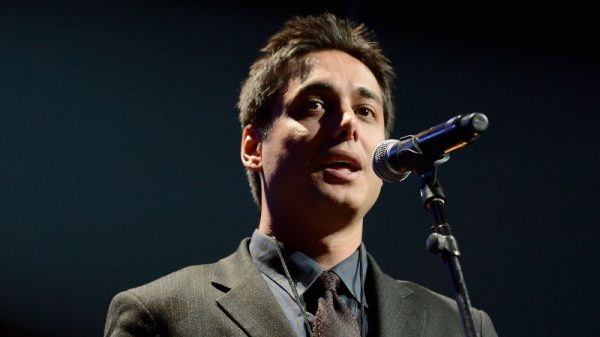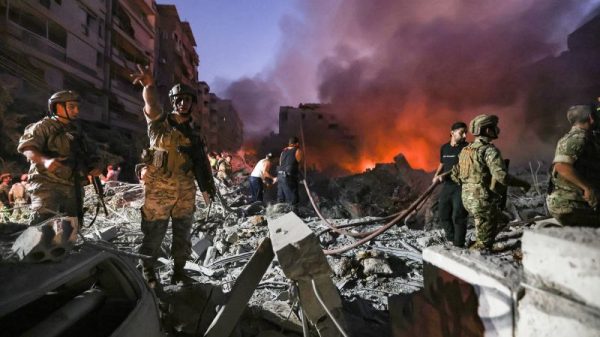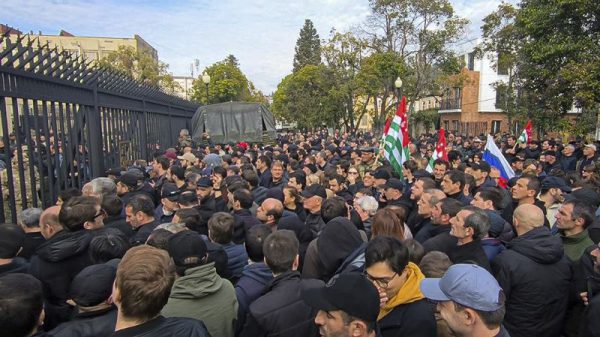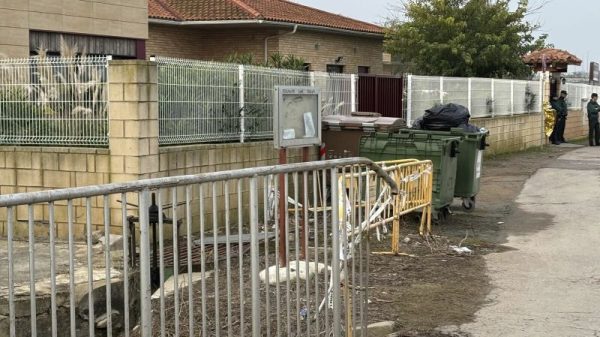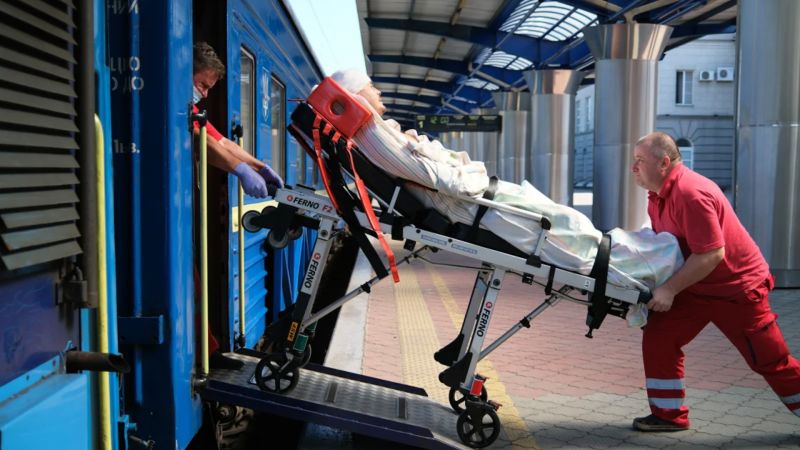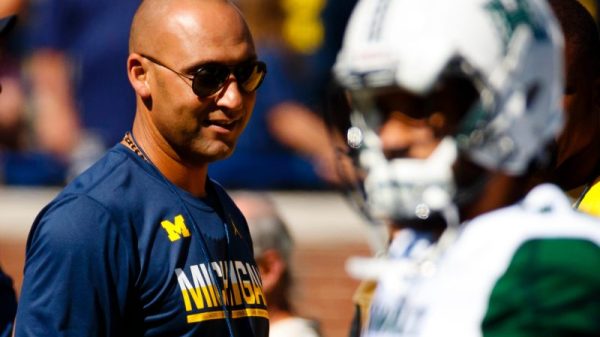Olga is running around the intensive care unit, constantly checking her patients’ oxygen levels, adjusting their medication and noting their vitals. She’s working fast, but even at her busiest, the nurse anesthetist doesn’t hesitate to pause to adjust a pillow or blanket, and make sure the injured soldiers in her care are as comfortable as possible amid the constant rocking and rumbling.
A sergeant in the Ukrainian military, she is attending to some of its sickest patients. It’s a busy job – and she is doing it on a speeding train.
Most cities in eastern Ukraine are struggling to find enough hospital beds to accommodate the almost constant stream of casualties from the frontlines. But freeing up space requires that even the sickest patients, many of them unconscious, are transferred to far-flung places, often hundreds of miles away.
Long ambulance journeys are too risky for people in a critical condition, and flying a helicopter is too dangerous given Russia’s air superiority over Ukrainian skies.
The train is a lifesaver.
He explained that his field – combat medicine – mostly involves stabilizing and evacuating patients to safety, rather than carrying out treatment. His work on the train is just one part of a medical chain that starts the moment a soldier is wounded.
“The most difficult part is evacuation from the frontline,” he said. “Combat medics who work on the front are dying just like soldiers.”
Running an ICU unit on a moving train is a herculean task that involves dozens of people and presents a unique set of challenges.
Oleksandr said the vast majority of his patients, some 90%, have suffered multiple shrapnel injuries. Many have had amputations, and several are intubated, alive thanks to ventilators and other life-support machines. All have numbers written on their hands showing which car of the long evacuation train they need to travel on.
“We are very limited in our capabilities here… If something happens, I cannot call an outside consultant,” he said.
“There may be minor operations, to stop bleeding. We cannot perform abdominal… and chest surgeries. We have to be very careful when selecting the patients,” he added.
Yevgeniy was severely wounded in a drone attack just two days before he was selected for evacuation on the ICU unit of the train.
Ukraine’s most important train
The railway hospital is an example of the kind of Ukrainian ingenuity that impressed the world in the early months of this conflict.
To limit rocking, the vehicle travels at about 80 kilometers (50 miles) per hour, which is about half the speed of a regular train. It also has priority over everyone else – including any special VIP trains carrying foreign dignitaries.
Even so, the ICU unit is constantly shaking. Every piece of equipment, every bed and every beeping machine needs to be anchored to the floor and the staff must take extra care when working on the patients.
Ambulance trains were first used during the Crimean War in the 1850s, but they have come a long way since then. The modern Ukrainian versions come equipped with ventilators, life support machines, ultrasound scanners and portable air conditioners that help maintain stable temperatures even on the hottest days.
Each carriage is a self-sustained unit powered by generators – an important safety feature given the frequent Russian attacks on Ukraine’s energy infrastructure, Pertsovskyi said.
But it is the little touches that make these trains truly special.
Children’s drawings and Ukrainian flags are on display in every car, offering some comfort to the bruised and battered passengers. The blind brackets on every window are shaped as a trident, the country’s national symbol, placed deliberately in the eyeline of soldiers lying in their beds.
A tale of two deployments
The train provides a small window into the brutal cost of war. Experienced warriors and new recruits are traveling together, united by injury and pain.
“They dropped a grenade. I was stunned. I have shrapnel in my hands, on my shoulders and on my back,” he said, adding that the blast wave damaged his hearing.
An electrician and a father of two, the 35-year-old was mobilized 18 months ago and was serving as an anti-tank gunner in an infantry battalion in the Donetsk region. In all that time, he has spent just 45 days away from the frontlines.
“Morale is high, but people are very tired,” he said with a blank stare, as the train kept chugging along.
“At this point you realize that everything depends not on you, but on God. Or on luck. When the bombs fall, there is not much you can do about it.”
It was a sobering assessment from a man with the callsign “Positive.”
Ukraine’s President Volodymyr Zelensky has long admitted that the military is struggling to replenish its ranks, leaving exhausted soldiers without a chance to rest.
At a news conference last month, Zelensky said this effort to recruit more soldiers was gathering steam. “Some rotations have started. I can’t call it fundamental rotations yet, to be honest. But it’s a start, and that’s very important,” he said.
Sitting just a few beds away from Oleksandr was Stanislav, who enlisted voluntarily just three months ago. He was also wounded by a drone that dropped into his trench, leaving him with a punctured lung, broken ribs and other injuries.
Wearing a sports jersey and shorts, he was adamant Ukraine would win the war, despite being outnumbered and outgunned by Russia.
“They use quantity, and we use quality,” he said.
The incredible price of war
Nearly nine hours into its journey, the hospital train finally pulled into a railway station in one of Ukraine’s cities. In the darkness of the night, a long line of ambulances was awaiting the patients. The train’s voyage was over, but their road to recovery was only starting. Some will likely never fully recover.
Olga, the ICU nurse, was getting ready to hand her patients over to the medics on the platform. Her job was done for the day.
She joined the military as a civilian nurse in 2015, a year after the conflict between Russian-backed separatists and Ukraine started in the eastern parts of the country, and Crimea was illegally annexed by the Kremlin. She enlisted in the military in 2016 and – except for a short break in 2022 – has served ever since.
“But we have the opportunity to provide much-needed help to our defenders 24/7, and that’s the best part.”
When the ambulances departed and the train left the station, Pertsovskyi, the railway chief, was finally able to breathe a sigh of relief. The medical train is thought to be a major target for Moscow and there have recently been several strikes targeting the vicinity of railway stations and other infrastructure.
Standing on the platform, just hours after he saw a train full of new recruits headed in the opposite direction, he reflected on the brutality of the conflict.
“In the morning, I see these kids who are saying goodbye to their dads who are heading towards the frontlines,” he said. “So, seeing those same guys coming back… unconscious or with amputations, it feels like the price of the war is incredible. It’s a conveyor belt.”












